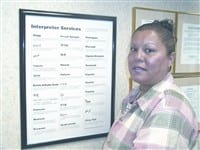Editorial Training Grants A Boost For Region’s Health Care Sector
Holyoke Chamber of Commerce Director Doris Ransford says that workforce development is synonymous with economic development.
She’s right.
But many don’t equate those two terms. When most people think of economic development they envision large companies coming into a region, bringing hundreds or thousands of jobs in the process. And they think about manufacturing or technology companies.
They think about big, banner headlines.
But economic development usually comes down to dozens of smaller headlines — ventures and initiatives that sometimes go unnoticed. And, in the Pioneer Valley, where the manufacturing sector is in decline and the technology fields are still trying a grab a foothold, economic development often means growth within the health care industry.
Indeed, health care, while always a strong component of the local economy, has become perhaps the driving force in recent growth. Large entities such as Baystate Health System, the Sisters of Providence Health System, Holyoke Medical Center, and Cooley Dickinson Hospital have all undertaken significant expansions and new building projects that have brought new jobs and new vitality to many area communities. But there has also been marked growth in the number and diversity of smaller health care ventures, in areas ranging from medical staffing to long-term care.
These smaller companies have helped expand broaden the base of the region’s health care sector and have thus provided a solid foundation for the future.
All this brings us to a press conference staged at Holyoke Medical Center early this month to announce the receipt of a $276,000 grant to be used toward workforce development at seven local companies: three health care providers, a nonprofit organization that provides assistance for the needy, and three manufacturing businesses.
The recipients of the grant funds, awarded by the Commonwealth Corporation, submitted proposals detailing a number of ways that career opportunities will be established for their employees, including new positions, workplace training, general education, and mentoring programs. The businesses also represent an accurate cross-section of Western Mass.; a strong faction of health care providers, organizations devoted to the region’s homeless and less fortunate population, and representatives from the struggling, though hopeful, manufacturing sector.
Within those health care facilities especially, excitement over the new programs that will begin thanks to that grant funding is palpable. A definitive answer to fiscal woes within the community it is not, but the substantial award has called attention to the work being done regionally to address financial issues effectively, creatively, and consistently.
At HMC, for example, 24 employees will soon have a new title and a spate of new, more advanced skills to add to their resumes. The career-ladder initiative will, in turn, allow those employees to better train and mentor future employees, in hopes of increasing employee retention rates, and above all, quality of care.
oomis Communities, no stranger to innovative programs for employees, will engage in a similar employee-training program, enrolling its non-clinical staff, such as housekeeping and food service employees, in a first responder training course. And Heritage Hall in Agawam will offer computer and basic skills classes for its employees as well as the employees within other grant-funded companies.
In the larger scheme of things, the grant award was not big news, or even big economic development news. But it was important news.
The grant will enable several smaller companies to become stronger and more competitive, and for their employees to better trained, and thus able to both provide better-quality services and survive and thrive in a rapidly changing work environment.
And as a result, the Pioneer Valley wins on a number of levels. It retains jobs, and gains the opportunity to gain more down the road. Meanwhile, its workforce becomes more attractive to companies thinking about making the region home.
The grant program provides another example of how this region, while it must always strive for the big economic headlines, needs to remain focused on the smaller headlines as well. A number of these smaller, often unnoticed developments can add up to big opportunities for the Valley.
Doris Ransford is right; workforce development is synonymous with economic development.


